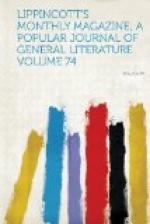ILLUSTRATIONS
Post-office department
building at Washington.
The Capitol at Washington and carpenters’
hall, where the first
colonial Congress met.
Hoe’s new perfecting printing-press,
printing 12,000 double
impressions per hour, and
the old Ephrata press.
The city of Tokyo, the largest steamship
built in America, and
FITCH’S steamboat, the
first constructed.
The cotton gin.
Grain elevator.
Interior of A postal car.
Prof. S.F.B. Morse, the inventor
of the electro-magnetic telegraph.
The school-house of the past and the present.
Windsor castle, from Eton.
Morton church.
MILTON’S Pear tree.
Gray.
Beaconsfield church.
Tomb of Burke.
HEDSOR and Cookham churches.
Eton college and chapel.
Eton college, from north terrace, Windsor.
Staines church.
Norman gate and round tower, Windsor.
HERNE’S oak.
East front, Windsor castle.
Queen ELIZABETH’S building, Windsor.
Earl of Surrey.
Windsor castle, from BISHOPSGATE.
Lock at Windsor.
The Thames embankment.
Elms near the heronry.
Hindu temples near Poona.
Gonds.
CENOTAPHS in the valley of the Tonsa.
The gaur, or Indian bison.
Banjaris.
LIPPINCOTT’S MAGAZINE
OF
POPULAR LITERATURE AND SCIENCE.
February, 1876.
THE CENTURY—ITS FRUITS AND ITS FESTIVAL.
II.—AMERICAN PROGRESS.
[Illustration: Post-office department building at Washington.]
From showing the world’s right to the epoch of ’76, and sketching the progress of the century in its wider aspect, a natural transition is to the part played in illustrating the period by the people from whose political birth it dates, and who have made the task of honoring it their own. They have reached their first resting-place, and pardonably enjoy the opportunity of looking back at the road they have traversed. They pause to contemplate its gloomy beginning, the perilous precipices along which it wound, and the sudden quagmires that often interrupted it, all now softened by distance and by the consciousness of success. Opening with a forest-path, it has broadened and brightened into a highway of nations.
So numerous and various were the influences, formative and impellent, which combined to bring the colonies up to the precise ripening-point of their independence, as to make it difficult to assign each its proper force. In the concentric mass, however, they stand out sharp and clear, and the conjoint effect seems preordained. That the event should have come when it did, and not before or after, is as obvious as any of history’s predictions after the fact. Looking through the glasses of to-day, we find it hard to realize that the Continental Congress renewed its expressions of loyalty to the king three weeks after the battle of Bunker Hill, so distinct before us rises the completed and symmetrical edifice of separation ready for its capstone, from its foundations growing steadily through the past.




